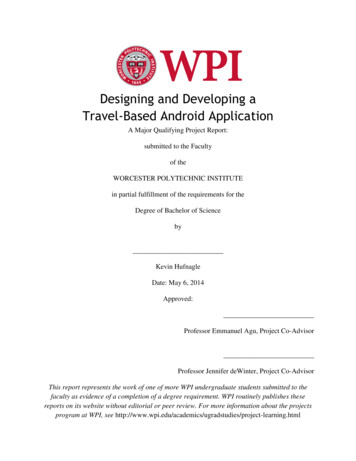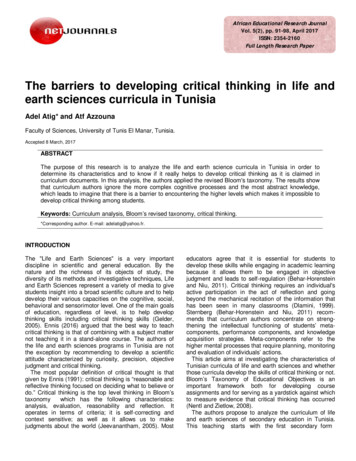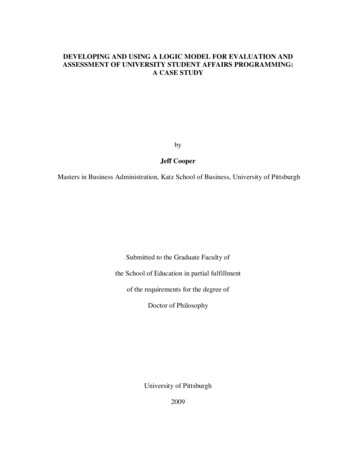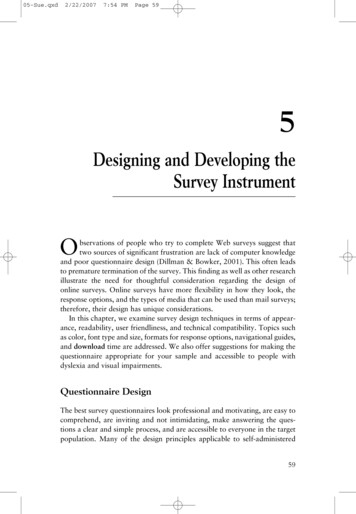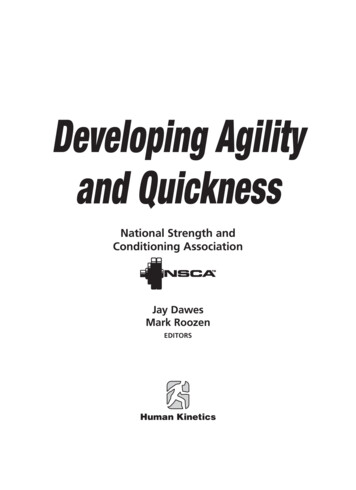
Transcription
Developing Agilityand QuicknessNational Strength andConditioning AssociationJay DawesMark RoozenEditorsHuman Kinetics
Library of Congress Cataloging-in-Publication DataDeveloping agility and quickness / Jay Dawes, Mark Roozen, editors.p. cm.Includes bibliographical references and index.ISBN-13: 978-0-7360-8326-3 (soft cover)ISBN-10: 0-7360-8326-X (soft cover)1. Sports sciences. 2. Sports--Physiological aspects. 3. Motor ability. 4. Motor learning. I. Dawes,Jay. II. Roozen, Mark, 1961- III. National Strength & Conditioning Association (U.S.)GV558.D45 2011613.71--dc232011025357ISBN-10: 0-7360-8326-X (print)ISBN-13: 978-0-7360-8326-3 (print)Copyright 2012 by National Strength and Conditioning AssociationAll rights reserved. Except for use in a review, the reproduction or utilization of this work in anyform or by any electronic, mechanical, or other means, now known or hereafter invented, includingxerography, photocopying, and recording, and in any information storage and retrieval system, isforbidden without the written permission of the publisher.The web addresses cited in this text were current as of June 2011, unless otherwise noted.Developmental Editor: Heather Healy; Assistant Editor: Claire Marty; Copyeditor:Joy Wotherspoon; Indexer: Nan N. Badgett; Permission Manager: Martha Gullo; Graphic Designer:Joe Buck; Graphic Artist: Julie L. Denzer; Cover Designer: Keith Blomberg; Photographer (cover):Ben Liebenberg/NFL via Getty Images; Photographer (interior): Neil Bernstein, Human Kinetics,unless otherwise noted; Photo Asset Manager: Laura Fitch; Visual Production Assistant:Joyce Brumfield; Photo Production Manager: Jason Allen; Art Manager: Kelly Hendren; AssociateArt Manager: Alan L. Wilborn; Art Style Development: Joanne Brummett; Illustrations: HumanKinetics, unless otherwise noted; Printer: Sheridan BooksWe thank the National Strength and Conditioning Association in Colorado Springs, Colorado, forassistance in providing the location for the photo shoot for this book.Human Kinetics books are available at special discounts for bulk purchase. Special editions orbook excerpts can also be created to specification. For details, contact the Special Sales Managerat Human Kinetics.Printed in the United States of America 10 987654321The paper in this book is certified under a sustainable forestry program.Human KineticsWebsite: www.HumanKinetics.comUnited States: Human KineticsP.O. Box 5076Champaign, IL 61825-5076800-747-4457e-mail: humank@hkusa.comAustralia: Human Kinetics57A Price AvenueLower Mitcham, South Australia 506208 8372 0999e-mail: info@hkaustralia.comCanada: Human Kinetics475 Devonshire Road Unit 100Windsor, ON N8Y 2L5800-465-7301 (in Canada only)e-mail: info@hkcanada.comNew Zealand: Human KineticsP.O. Box 80Torrens Park, South Australia 50620800 222 062e-mail: info@hknewzealand.comEurope: Human Kinetics107 Bradford RoadStanningleyLeeds LS28 6AT, United Kingdom 44 (0) 113 255 5665e-mail: hk@hkeurope.comE4818
Developing Agilityand Quickness
ContentsIntroduction viiKey to Diagrams xi12ivFactors Determining Agility . . . . . 1Factors DeterminingQuickness . . . . . . . . . . . . . . . . . . . 253Testing Agility and Quickness . . 354Agility Drills . . . . . . . . . . . . . . . . . . . 555Quickness Drills . . . . . . . . . . . . . . . . 93
67Agility and Quickness ProgramDesign . . . . . . . . . . . . . . . . . . . . . 115Sport-Specific Agility andQuickness Training . . . . . . . . . 127ReferencesIndex161173About the NSCA 179About the Editors 181About the Contributors 183v
This page intentionally left blank.
IntroductionFor all athletes, the ability to quickly change direction is often the difference between success and failure. Virtually all sports involve whole-bodymovements that require athletes to rapidly and instantly accelerate,decelerate, or change direction in response to game situations. The reality isthat in most sports, the ability to quickly change direction is more important than great straight-line sprinting speed. For this reason, many coachesand athletes are interested in finding effective ways to improve agility andquickness. The purpose of this book is to assist sports coaches, athletes, andstrength and conditioning professionals in accomplishing this goal.In 2002, Young, Jones, and Montgomery attempted to identify the mostsignificant factors influencing agility performance. In particular, these authorsdivided agility performance variables into two main areas: change of directionspeed and perceptual and decision-making factors.7 Within these two maincomponents, several subcomponents exist, as outlined in figure 1. Agility andquickness are complex sporting skills that include both physical and cognitivecomponents.1, 2, 3, 4, 5, 6, 7 An example is a kick or punt returner in Americanfootball waiting patiently to receive a ball who must immediately decidewhich way to maneuver through the defense to gain yardage. Or, imaginea point guard who dribbles down the lane and must determine whether tocontinue dribbling, pass the ball, or shoot. These are prime examples of howathletes must move and think fast to achieve lightning quickness on the fieldor court. Therefore, to maximize performance, athletic training programsmust address both the physical and cognitive components of agility andquickness. Only then will athletes be able to truly bridge the gap betweenpractice and competition.Chapter 1 discusses factors that influence agility, such as change-ofdirection speed, proper technique, body position, and physical attributes. Italso covers the essential components of developing rapid force, high poweroutput, and explosive movement, as well as how these fundamental attributesinfluence athletes’ ability to achieve high-level performance.Chapter 2 explores perceptual and decision-making skills (i.e., quicknessfactors), such as information processing, knowledge of situations, anticipation,and arousal and anxiety levels. Athletes with high-level agility performanceare better at recognizing and capitalizing on task- and game-relevant cuesthat give them a competitive advantage over their opponents. In many cases,these skills separate elite performers from everyone else.vii
viii IntroductionAgilityChange ofdirection speedPerception anddecision edgeof situationsLegmusclequalitiesStrength PowerReactivestrengthTechniqueFootplacementFigure 1BodyAdjustmentlean andof stridespostureto accelerateand decelerateComponents of agility.Adapted, by permission, from W.B. Young, R. James, and I. Montgomery, 2002, “Is musclepower related to running speed with changes of direction?” Journal of Sports Medicine andPhysical Fitness 42(3):282-288.As with any training program, athletes must be physically prepared forthe demands of training. Agility and quickness training is no different.Therefore, prior to the chapters with specific drills to enhance agility andquickness (chapters 4 and 5), chapter 3 discusses techniques to evaluate anE4818/NSCA/Fig Intro F/412898/Tammy Page/R1athlete’s readiness in detail. This chapter also presents methods for monitoring athletes’ progress with both qualitative-movement assessments and teststhat predict agility performance.Chapters 4 and 5 present a wide variety of drills to improve agility andquickness. Many of these drills develop general motor programs and improvefundamental movement skills for future athletic success. These chapters alsoinclude suggestions and specific training drills that incorporate cognitive
Introductiondecision-making tasks into athletes’ training programs once they havemastered the techniques. These unplanned, or open, drills require athletesto process information from the environment and to respond quickly withaccuracy and precision.The selected drills provide a solid base of information to assist in the develop ment of athlete-specific and sport-specific training programs. Chapter 6explores the basic foundations of designing agility and quickness programs. Inchapter 7, professionals from a variety of sports share their personal philosophies on agility and quickness training and their favorite drills for improvingsport performance at a variety of skill levels. The drills in this chapter addsport-specific training stimulus to the program, which better prepares athletesfor the chaotic nature of sport and competition.This book serves as a basic guide and resource for the safe and effectivedevelopment of comprehensive training programs for agility and quickness.It is an absolute must-have resource for coaches and athletes who are serious about taking performance to the next level. It is loaded with invaluabletraining tips and information that the experts in this book have taken a lifetime to develop. The authors hope that athletes, coaches, and performanceenthusiasts will gain an appreciation and a better understanding of what ittakes to improve agility and quickness. Excellence is not an accident! ix
This page intentionally left blank.
Key to DiagramsStep with left footStep with right foot12Numbers indicate order of stepsFoot touch or tap (no weight transfer)ConeSprintSide shuffleBackpedalBear crawlCariocaDefensive player or any playerOffensive playerE4818/NSCA/KTD/413039/Tammy Page/R3-khxi
This page intentionally left blank.
Chapter1Factors DeterminingAgilityMark RoozenDavid N. SuprakMost team sports, such as basketball, American football, and soccer,are characterized by rapid acceleration, deceleration, and changesof direction within a 10-yard (9 m) window.45 Furthermore, courtsports, like tennis and volleyball, also require multidirectional first-step quickness and changes of direction within a 4- to 10-meter (4–11 yard) span.40According to numerous coaches and sport scientists, an agility task is a rapid,whole-body change of direction or speed in response to a stimulus.41, 53 Agilitycan be broken down into subcomponents made up of both physical qualities and cognitive abilities.53 This chapter examines the physical qualities ofspeed, strength, power, and technique, as well as the qualities of leg muscles.SpeedAthletes who can move faster than their opponents have an advantage. Forexample, a faster athlete may be able to get to a ball more quickly than acompetitor or may even outrun a pursuer. For this reason, athletes in mostsports value speed highly. Speed is often measured by using linear (straightline) sprinting over a distance between 40 and 100 yards (37–91 m). However,it is important to remember that in most sports, athletes rarely sprint morethan 30 yards (27 m) in a straight line before they must make some type ofdirectional change. Unless an athlete is a 100-meter sprinter, focusing a greatdeal of time and attention on straight-ahead speed may not result in optimumperformance. On the other hand, since most sports require acceleration froma static state or when transitioning between movements, straight-line speedis still a valuable asset that athletes should focus on when testing and training for sports.1
Developing Agility and QuicknessAP Photo/Charles Rex Arbogast2Derrick Rose accelerates past an opponent.Linear sprinting is a physical skill that most people have performed sincetheir second year of life with some level of proficiency.22 For decades, manycoaches believed that linear speed was mostly related to genetics and couldnot be significantly improved by training. However, appropriate training doesimprove running speed, even at the elite level. The combination of striderate (the number of strides per unit of time) and stride length (the distancecovered in a single stride) primarily determines linear speed. So, athletescan improve linear speed by increasing stride rate while maintaining stridelength, increasing stride length while maintaining stride rate, or doing acombination of both.Most sports, with the exception of track-and-field sprinting, involve shortsprints ( 30 yards) and rapid changes of direction, followed by rapid accelerations. For this reason, it makes little sense to focus a large proportion oftraining time on improving speed capabilities for athletes who will rarelyreach maximum speed in competition. It makes more sense for these athletesto focus their attention on training to accelerate.33 Acceleration is the rate ofchange in velocity, so this phase of sprinting is critical for changing directionsas rapidly and efficiently as possible.Optimal technique for linear sprinting in the acceleration phase involvesfour factors that maximize stride length and frequency:34
Factors Determining Agility1. The body should have a pronounced forward lean that results in a lowercenter of mass. Consequently, momentum in a linear direction increases.This position initiates foot contact with the ground under or slightlybehind the center of mass, reducing forces that cause an athlete to slowdown or brake.382. When pushing off the ground during the propulsion phase, the foottouches the ground in a cocked position, with the ankle flexed upwardat approximately 90 degrees (dorsiflexion) and the toes pointed backtoward the shin. Once the foot makes contact with the ground, the athleteextends the hip, knee, and ankle simultaneously with as much force aspossible (see figure 1.1). This movement is known as triple extension.473. During the recovery phase, the ankle of the free leg should be dorsiflexedwhile the knee and hip are bent, or flexed. This allows the foot to passdirectly under the buttocks and a more rapid turnover at the hip.4. The athlete should make certain to initiate arm swing at the shoulderwith the elbow flexed to 90 degrees. He should work on swinging thearm forcefully backward to let the body’s stored elastic energy and stretchreflex provide much of the arm’s forward propulsion.10Figure 1.1 Proper technique for str
As with any training program, athletes must be physically prepared for the demands of training. Agility and quickness training is no different. Therefore, prior to the chapters with specific drills to enhance agility and quickness (chapters 4 and 5), chapter 3 discusses techniques to evaluate an athlete’s readiness in detail. This chapter also presents methods for monitor-ing athletes .
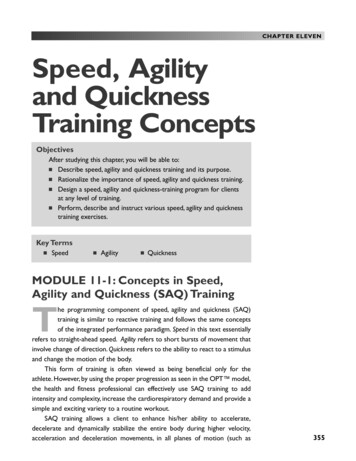
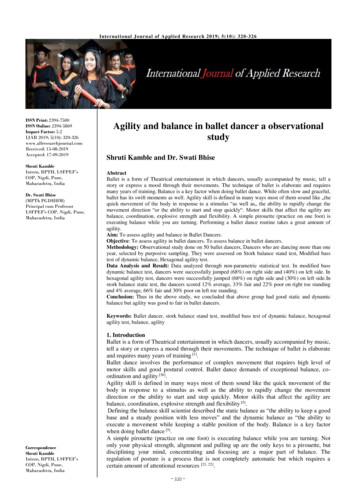

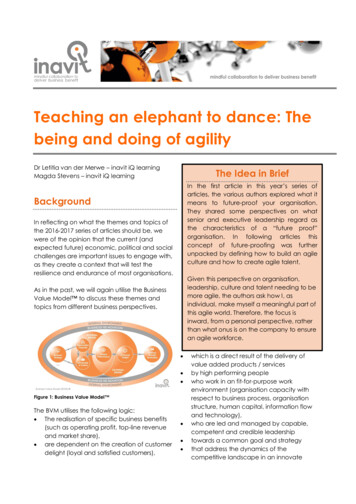



![Josh Smith - Agility [Read-Only]](/img/8/disaster-planning.jpg)
